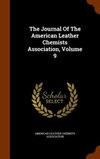通过氯化氰改性壳寡糖生产可持续皮革制造用生物质鞣剂
IF 0.5
4区 工程技术
Q4 CHEMISTRY, APPLIED
Journal of The American Leather Chemists Association
Pub Date : 2023-10-02
DOI:10.34314/jalca.v118i10.8230
引用次数: 0
摘要
开发替代鞣剂以避免传统铬鞣带来的潜在环境和人类健康风险,对皮革行业至关重要。在这项工作中,我们通过将壳寡糖(COS)与氯化氰(CC)进行改性,制备了一种生态友好型生物质基鞣剂--二氯三嗪基壳寡糖(DTCS),用于无铬皮革制造。对这种生物质基鞣剂的合成进行了系统优化,以获得接枝度高达 67%、重量平均分子量(Mw)为 1465 g/mol 的目标产品。研究了使用 DTCS 的非挑染鞣制过程,并研究了 DTCS 与胶原纤维之间的相互作用。结果表明,鞣革的水热稳定性显著提高,即收缩温度(Ts)超过 82.0°C,机械性能也得到改善。此外,皮革的感官特性(如丰满度、柔软度和粒面紧密度)也有明显改善。这项研究不仅为清洁皮革制造提供了一种可靠的方法,同时也解决了潜在的生态压力,还凸显了生物质材料在皮革工业中的新兴用途。本文章由计算机程序翻译,如有差异,请以英文原文为准。
Biomass-based Tanning Agent for Sustainable Leather Manufacture via Cyanuric Chloride Modified Chitooligosaccharide
Developing alternative tanning agents to avoid the potential environmental and human health risks from the conventional chrome tanning is essential for the leather industry. In this work, we prepared an eco-friendly biomass-based tanning agent dichlorotriazinyl chitooligosaccharide (DTCS) by modifying chitooligosaccharide (COS) with cyanuric chloride (CC) for chrome-free leather manufacture. The synthesis of such biomass-based tanning agent was systematically optimized to obtain the target product with high grafting degree of 67% and weight-average molecular weight (Mw) of 1465 g/mol. The non-pickling tanning procedure using DTCS was investigated, and the interactions between DTCS and collagen fibers were studied. Our results showed that the hydrothermal stability of the tanned leather was significantly increased, i.e., the shrinkage temperature (Ts) exceeding 82.0°C, and the mechanical properties were improved. Moreover, the organoleptic properties of leather (e.g., fullness, softness and grain tightness) exhibited obvious improvement. This research not only offers a reliable approach for cleaner leather manufacturing while addressing the underlying ecological pressure, but also highlights the emerging use of biomass materials in the leather industry.
求助全文
通过发布文献求助,成功后即可免费获取论文全文。
去求助
来源期刊

Journal of The American Leather Chemists Association
工程技术-材料科学:纺织
CiteScore
1.30
自引率
33.30%
发文量
29
审稿时长
3 months
期刊介绍:
The Journal of the American Leather Chemists Association publishes manuscripts on all aspects of leather science, engineering, technology, and economics, and will consider related subjects that address concerns of the industry. Examples: hide/skin quality or utilization, leather production methods/equipment, tanning materials/leather chemicals, new and improved leathers, collagen studies, leather by-products, impacts of changes in leather products industries, process efficiency, sustainability, regulatory, safety, environmental, tannery waste management and industry economics.
 求助内容:
求助内容: 应助结果提醒方式:
应助结果提醒方式:


